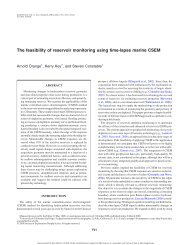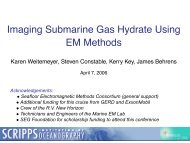Inversion of magnetotelluric data for 2D structure with sharp ...
Inversion of magnetotelluric data for 2D structure with sharp ...
Inversion of magnetotelluric data for 2D structure with sharp ...
Create successful ePaper yourself
Turn your PDF publications into a flip-book with our unique Google optimized e-Paper software.
80 de Groot-Hedlin and ConstableThe n r × (n r + 1) matrix S rho operates only on the resistivityparameters, and is defined by⎛⎞c −c 0 0 ...S rho =0 c −c 0 ...⎜⎝ ...⎟⎠ , (3)... c −cwhere c is a constant that controls the relative weighting betweenlayer roughness and resistivity contrasts. The penaltymatrix S dep acts only on the depth parameters, and is given by⎛⎞S 1 0 ...S dep =0 S 2 0 ...⎜⎝ ...⎟⎠ , (4)... 0 S n rwhere 0 is an (n c − 1) × n c matrix <strong>of</strong> zeros and S i is the(n c − 1) × n c roughening matrix <strong>for</strong> the bottom <strong>of</strong> the ith layer,i.e.,⎛⎞1 −1 0 ...S i =0 1 −1 0 ...⎜⎝ ...⎟⎠ . (5)... 0 1 −1Thus S i differences the model depth parameters between laterallyadjacent columns in layer i.We simultaneously minimize model roughness and <strong>data</strong> misfitby finding a stationary point <strong>for</strong> the functionalU =‖Sm‖ 2 + µ −1[ ‖W(d − F[m])‖ 2 − χ 2 ∗]. (6)The trade-<strong>of</strong>f between the <strong>data</strong> misfit, given by the second term,and the model roughness is controlled by the Lagrange multiplierµ −1 . In equation (6), d represents the <strong>magnetotelluric</strong><strong>data</strong>, F[m] is a nonlinear <strong>for</strong>ward functional F acting uponthe model m to produce the model response, χ∗ 2 is the desiredlevel <strong>of</strong> fit, and W is a diagonal matrix <strong>with</strong> entries inverselyproportional to the <strong>data</strong> errors.Since the <strong>for</strong>ward functional F[m] is nonlinear <strong>with</strong> respectto perturbations in resistivity or boundary depth, we linearizeabout a starting model m i . The first two terms <strong>of</strong> the Taylorapproximation yieldF[m i + m] = F[m i ] + J i m, (7)where J i is the Jacobian matrix <strong>of</strong> partial derivatives <strong>of</strong> F[m i ]<strong>with</strong> respect to the model parameters. The stability <strong>of</strong> any linearizedinversion method is controlled largely by the accuracy<strong>of</strong> this approximation. In MT, equation (7) is a good approximation<strong>for</strong> models <strong>with</strong> limited conductivity contrasts; thus,linearized inversion methods tend to be highly robust <strong>for</strong> inversionsthat limit conductivity variability. With the large conductivitycontrasts that are characteristic <strong>of</strong> inversions <strong>for</strong> boundarylocations, this approximation becomes less accurate, andthe iterations may reach local, rather than global, minima inthe solution space. In the next two sections, we discuss methodsto avoid converging to a local minimum.We use the <strong>2D</strong> finite element code <strong>of</strong> Wannamaker et al.(1987) to derive <strong>for</strong>ward responses, and the adjoint method,described in deLugao and Wannamaker (1996), to computepartial derivatives <strong>of</strong> F[m i ] <strong>with</strong> respect to conductivity. Use <strong>of</strong>the adjoint method allows us to obtain the model sensitivities<strong>with</strong> respect to conductivity at minimal computational cost.To take advantage <strong>of</strong> the computational time saving <strong>of</strong>feredby use <strong>of</strong> the adjoint method, we use a chain rule method toconvert derivatives <strong>with</strong> respect to conductivity to derivatives<strong>with</strong> respect to depth. This is described in greater detail in theAppendix.As derived in Constable et al. (1987), the model m i+1 is givenby the stationary points <strong>of</strong> U, i.e.,m i+1 = [ µ(S T S) + (WJ i ) T (WJ i ) ] −1(WJi ) T W ˆd i , (8)where ˆd i is given by d − F[m i ] + J i m i . Note that we need S T S,not S itself. We use sparse matrix multiplication to computeS T S efficiently. Boundary depths computed from equation (8)are adjusted to the value <strong>of</strong> the nearest block boundary, asindicated in Figure 1, prior to computation <strong>of</strong> the <strong>for</strong>ward response.Given that model sensitivities <strong>with</strong> respect to depth aremuch smaller than the derivatives <strong>with</strong> respect to unit conductivity,this does not significantly alter the model responses. Ateach iteration, we vary µ to find the model which generates theminimum misfit, and use this model as the starting point in thenext iteration. If the misfit is less than χ ∗ , we increase µ to findsmoother models until the desired misfit is attained.Unlike <strong>for</strong> the Occam method (de Groot-Hedlin and Constable,1990), the starting model <strong>for</strong> this algorithm must possesssome resistivity contrasts. One reason is that our method<strong>of</strong> computing derivatives <strong>with</strong> respect to resistivity (describedin the Appendix) requires that some conductivity contrast ispresent in adjacent units. Another reason is that we initializeboundary depths in terms <strong>of</strong> where conductivity contrasts existin the initial model. For subsequent inversions, intermediatemodel solutions that feature very low resistivity contrasts betweenadjacent layers can also yield instability in the algorithm,since the model response is insensitve to perturbations in theboundary depth between two adjacent units <strong>with</strong> almost identicalresistivity. In this case, the two units can be merged intoone <strong>for</strong> further iterations. Also note that, because boundariesare parameterized in terms <strong>of</strong> the logarithm <strong>of</strong> the depth ratherthan thickness, the solution <strong>of</strong> equation (8) allows layer boundariesto cross over. When this occurs, we set the depth <strong>of</strong> the“lower” boundary equal to that <strong>of</strong> the “upper” boundary, thuspinching out a portion <strong>of</strong> the intermediate layer. Layers thatare completely pinched out in an inversion must be removed<strong>for</strong> further iterations to maintain stability.In application, we found that the algorithm converged slowlyunless we chose a fairly good starting model. One option, usedin the real <strong>data</strong> example, is to find the best layered model fittingthe <strong>data</strong> <strong>with</strong> a 1D inversion algorithm, and use this layeredsolution as a starting model <strong>for</strong> the <strong>2D</strong> algorithm. Anotheroption is to use results from the smooth Occam method tobuild a starting model. We note that different starting modelsmay yield different model solutions, especially when solving<strong>for</strong> a model <strong>with</strong> many layers. We attribute this to the inherentnonlinearity <strong>of</strong> the MT problem in the presence <strong>of</strong> <strong>sharp</strong>resistivity contrasts; the solution space <strong>of</strong> a nonlinear problemmay possess many local minima in which a linearized algorithm




